CA Driver's Handbook
0.0(0)
0.0(0)
Card Sorting
1/117
Earn XP
Description and Tags
For The Permit Test :)
Study Analytics
Name | Mastery | Learn | Test | Matching | Spaced |
|---|
No study sessions yet.
118 Terms
1
New cards
Hand to Hand Steering
1\. Start with your hands at 9 and 3 o’clock or 8 and 4 o’clock.
2\. Do not cross your hands over the middle of the steering wheel.
3\. Keep your hands in these positions, even when making turns.
2\. Do not cross your hands over the middle of the steering wheel.
3\. Keep your hands in these positions, even when making turns.
2
New cards
Hand over Hand Steering
1\. Start with your hands at 8 and 4 o’clock.
2\. Reach across the steering wheel to grasp the opposite side.
3\. Let go of the steering wheel with your other hand.
4\. Reach across the arm still holding the wheel, grip the wheel, and pull up.
2\. Reach across the steering wheel to grasp the opposite side.
3\. Let go of the steering wheel with your other hand.
4\. Reach across the arm still holding the wheel, grip the wheel, and pull up.
3
New cards
One-Hand Steering
There are only two situations that may require steering with one hand:
• When you are turning while backing up to see where you are going behind you. Place your hand at the 12 o’clock position on the steering wheel.
• When you are operating vehicle controls that require you to remove a hand from the steering wheel.
• When you are turning while backing up to see where you are going behind you. Place your hand at the 12 o’clock position on the steering wheel.
• When you are operating vehicle controls that require you to remove a hand from the steering wheel.
4
New cards
Signaling
Left arm out stretched = Left Turn
Left Arm Perpendicular = Right Turn
Left Arm Perpendicular pointed down = Stop/ Slow
Left Arm Perpendicular = Right Turn
Left Arm Perpendicular pointed down = Stop/ Slow
5
New cards
When Should You Signal?
• At least 100 feet before you turn.
• Before every lane change.
• At least five seconds before you change lanes on a freeway.
• Before pulling next to the curb or away from the curb. • Even when you do not see other vehicles around you. • When you are almost through the intersection if you plan to turn shortly after crossing the intersection.
• Before every lane change.
• At least five seconds before you change lanes on a freeway.
• Before pulling next to the curb or away from the curb. • Even when you do not see other vehicles around you. • When you are almost through the intersection if you plan to turn shortly after crossing the intersection.
6
New cards
Using Your Horn
• Avoid collisions.
• Alert oncoming traffic on narrow mountain roads where you cannot see at least 200 feet ahead.
• Alert oncoming traffic on narrow mountain roads where you cannot see at least 200 feet ahead.
7
New cards
Headlight Etiquette
* Dim your high-beam headlights to low beams within **500 ft** of a vehicle **coming toward you**
* Dim your high-beam headlights to low beams within **300 ft** of a vehicle **you‘re following**
* Dim your high-beam headlights to low beams within **300 ft** of a vehicle **you‘re following**
8
New cards
When to use Your Headlights
* When it is too dark to see from 1,000 feet away.
* • Beginning 30 minutes after sunset. •
* Until 30 minutes before sunrise.
* • In adverse weather. If you need to use your windshield wipers due to fog, rain, or snow, you must turn on your low-beam headlights.
* When conditions (such as clouds, dust, smoke, or fog) prevent you from seeing other vehicles. •
* On mountain roads and tunnels (even on sunny days). •
* When a road sign states that headlights must be on. •
* To help other drivers see your vehicle, especially when the sun is low on the horizon.
* • Beginning 30 minutes after sunset. •
* Until 30 minutes before sunrise.
* • In adverse weather. If you need to use your windshield wipers due to fog, rain, or snow, you must turn on your low-beam headlights.
* When conditions (such as clouds, dust, smoke, or fog) prevent you from seeing other vehicles. •
* On mountain roads and tunnels (even on sunny days). •
* When a road sign states that headlights must be on. •
* To help other drivers see your vehicle, especially when the sun is low on the horizon.
9
New cards
Using Your Emergency Flashers
• Turn on your emergency flashers.
• Lightly tap your brake pedal three or four times.
• Use a hand signal when slowing and stopping
• Lightly tap your brake pedal three or four times.
• Use a hand signal when slowing and stopping
10
New cards
If You Need to Stop Because of __Vehicle Trouble__
* Turn on your emergency flashers. If your vehicle does not have emergency flashers, use your turn signals.
* If possible, pull off the road away from all traffic.
* If you cannot get completely off the road, stop where people can see you and your vehicle from behind.
* Do not stop just over a hill or just around a curve. Other drivers may not see your vehicle in time to avoid a collision.
* Call for emergency roadside assistance and stay in your vehicle until help arrives.
* If possible, pull off the road away from all traffic.
* If you cannot get completely off the road, stop where people can see you and your vehicle from behind.
* Do not stop just over a hill or just around a curve. Other drivers may not see your vehicle in time to avoid a collision.
* Call for emergency roadside assistance and stay in your vehicle until help arrives.
11
New cards
Single Solid Yellow Line
* Marks the Center of a road with 2-way traffic
* __Do not__ pass a vehicle in front of you if there is only one lane of traffic going your direction and a solid yellow line on your side of the road
* __Do not__ pass a vehicle in front of you if there is only one lane of traffic going your direction and a solid yellow line on your side of the road
12
New cards
Double Solid Yellow Lanes
* __Do not__ pass over double solid yellow lines
* Stay to the right of these lines __unless you are:__
* HOV carpool lane w/ a designated entrance
* Instructed by construction
* Turning left across a single set of these lines to enter or exit a driveway or private road or make a U-turn
* 2 Sets of Solid double yellow lines spaced __2 or more ft apart are a barrier__
* Do not drive on or over this, make a left turn, or make a U-turn
* Stay to the right of these lines __unless you are:__
* HOV carpool lane w/ a designated entrance
* Instructed by construction
* Turning left across a single set of these lines to enter or exit a driveway or private road or make a U-turn
* 2 Sets of Solid double yellow lines spaced __2 or more ft apart are a barrier__
* Do not drive on or over this, make a left turn, or make a U-turn
13
New cards
Broken Yellow Line
you may pass if the broken line is next to your driving lane
14
New cards
Single Solid White Line
marks traffic lanes going in the same direction
(this includes 1 way streets)
(this includes 1 way streets)
15
New cards
Double Solid White Lines
* a lane barrier between a regular use and a HOV lane
* __Never__ change lanes over double solid white lines, __wait__ until you see a single broken white line
* __Never__ change lanes over double solid white lines, __wait__ until you see a single broken white line
16
New cards
End of Lane Markings
* Ending freeway and street lanes are marked by this
\
\
17
New cards
Yield Lane
a solid white line of triangles that shows approaching vehicles where to yield of stop
18
New cards
Choosing a Lane (Tips)
* Use the left lane to pass or turn left
* Use the right lane to __enter__ or __exit__ traffic
* Use the right lane to __enter__ or __exit__ traffic
19
New cards
What to do before you Change Lanes
Signal. •
Check your mirrors. •
Check traffic behind and beside you. •
Look over your shoulder in the direction you plan to move to make sure the lane is clear. •
Check your blind spots for other vehicles, motorcyclists, and bicyclists. Do not let the vehicle drift into another lane. •
Be sure there is enough space for your vehicle in the next lane. It is not necessary to slow down before a lane change.
Stay in one lane as much as possible
Check your mirrors. •
Check traffic behind and beside you. •
Look over your shoulder in the direction you plan to move to make sure the lane is clear. •
Check your blind spots for other vehicles, motorcyclists, and bicyclists. Do not let the vehicle drift into another lane. •
Be sure there is enough space for your vehicle in the next lane. It is not necessary to slow down before a lane change.
Stay in one lane as much as possible
20
New cards
Passing Lanes
the far left lane closest to the center divider
* Used to pass other vehicles
* Used to pass other vehicles
21
New cards
Carpool/HOV Lanes
To use these lanes, one of these must apply:
* You have a certain number of people in your vehicle. There will be signs at the on-ramp or along the road to tell you the minimum number of people. Road signs also list the hours when the HOV rules apply.
* You are driving a low emission or zero emission vehicle. You must display a special DMV-issued decal.
* You are riding a motorcycle (unless otherwise posted).
* You have a certain number of people in your vehicle. There will be signs at the on-ramp or along the road to tell you the minimum number of people. Road signs also list the hours when the HOV rules apply.
* You are driving a low emission or zero emission vehicle. You must display a special DMV-issued decal.
* You are riding a motorcycle (unless otherwise posted).

22
New cards
Center Left Turn Lanes
* Located in the middle of a 2-way street
* Marked on both sides by 2 painted lines w the inner line broken and outer line solid
* Use to prepare for and make a left turn or a U-turn
* You may only drive for **200 ft**
To Turn left:
do the “what to do before you change lanes” thing
* Marked on both sides by 2 painted lines w the inner line broken and outer line solid
* Use to prepare for and make a left turn or a U-turn
* You may only drive for **200 ft**
To Turn left:
do the “what to do before you change lanes” thing
23
New cards
Turnout Areas or Lanes
* Merge into these areas or lanes to allow cars behind you to pass
* You must use a turnout area or lane to let other vehicles pass when you are driving slowly on a two-lane road
* Where passing is unsafe, and there are five or more vehicles following you
* You must use a turnout area or lane to let other vehicles pass when you are driving slowly on a two-lane road
* Where passing is unsafe, and there are five or more vehicles following you

24
New cards
Bicycle Lanes
It’s illegal to drive in a bicycle lane __unless__ you are:
* Parking (where permitted).
* Entering or leaving the road.
* Turning (within 200 feet of an intersection).
* Parking (where permitted).
* Entering or leaving the road.
* Turning (within 200 feet of an intersection).
25
New cards
Buffered Bike Lane
Uses chevrons or diagonal markings to provide greater separation from traffic and on-street parking.
26
New cards
Bike Route
Uses bike route signs and shared road markings to designate a preferred route for bicyclists on streets shared with vehicle traffic
27
New cards
Separated Bikeway
Is physically separated from motor vehicle traffic and for exclusive use of bicyclists.
separation may include flexible posts, grade separation, inflexible barriers, or on-street parking.
separation may include flexible posts, grade separation, inflexible barriers, or on-street parking.
28
New cards
Shared Roadway Bicycle Markings
Alert drivers that bicyclists can occupy the lane and help bicyclists maintain a safe lane position in traffic.
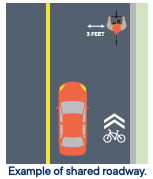
29
New cards
To make a Right Turn
* Drive close to the right edge of the road
* If a designated right turn lane is available, enter at the opening
* You can drive in a bike lane within **200ft** from the turn
* Watch for pedestrians, bicyclists, or motorcyclists between your vehicle and the curb.
* Start signaling about 100 feet before the turn.
* Look over your right shoulder and reduce your speed.
* Stop behind the limit line. A limit line is a wide white line that shows the drivers where to stop before an intersection or crosswalk. If there is no limit line, stop before you enter the crosswalk. If there is no crosswalk, stop before you enter the intersection.
* Look both ways (left-right-left) and turn when it is safe.
* Complete your turn in the right lane. Do not turn wide into another lane
* If a designated right turn lane is available, enter at the opening
* You can drive in a bike lane within **200ft** from the turn
* Watch for pedestrians, bicyclists, or motorcyclists between your vehicle and the curb.
* Start signaling about 100 feet before the turn.
* Look over your right shoulder and reduce your speed.
* Stop behind the limit line. A limit line is a wide white line that shows the drivers where to stop before an intersection or crosswalk. If there is no limit line, stop before you enter the crosswalk. If there is no crosswalk, stop before you enter the intersection.
* Look both ways (left-right-left) and turn when it is safe.
* Complete your turn in the right lane. Do not turn wide into another lane
30
New cards
Right Turn Against a Red Light
You may turn right at a red light after a complete stop __unless__ there’s a *No Turn on Red* sign
31
New cards
Right Turn Against a Red Arrow
You may **NOT** turn right if you are stopped at a red arrow light. __Wait__ until the light turn green to turn
32
New cards
Right Turn at a Public Transit Bus Lane
It is __illegal__ to **drive**, **stop, park, or leave a vehicle** in an area designated for public transit buses.
Signs will be posted to indicate the lanes are for bus only use.
However, you may cross a bus lane to make a __right turn__.
Signs will be posted to indicate the lanes are for bus only use.
However, you may cross a bus lane to make a __right turn__.
33
New cards
To Turn Left
* Drive close to the center divider or into the left turn lane.
* — Enter a designated left turn lane at the opening. Do not cross any solid line.
* Enter a two-way center left turn lane within 200 feet of the turn. Respect the right-of-way of any vehicle, bicyclist, or motorcyclist already in the lane. Always yield to pedestrians.
* Start signaling 100 feet before the turn.
* Look over your left shoulder and reduce your speed. •
* Stop behind the limit line. If there is no limit line, stop before you enter the crosswalk. If there is no crosswalk, stop before you enter the intersection.
* Look both ways **(left-right-left)** and begin your turn when it is safe.
* Proceed into the intersection while turning to complete your turn in the left lane.
* Do not turn the steering wheel too soon and enter the lane of oncoming vehicles.
* Keep your wheels pointed straight ahead until it is safe to start your turn. If your wheels are pointed to the left and a vehicle hits you from behind, you could be pushed into oncoming traffic.
* Accelerate smoothly during and after the turn.
* Allow the steering wheel to straighten in the new lane
* — Enter a designated left turn lane at the opening. Do not cross any solid line.
* Enter a two-way center left turn lane within 200 feet of the turn. Respect the right-of-way of any vehicle, bicyclist, or motorcyclist already in the lane. Always yield to pedestrians.
* Start signaling 100 feet before the turn.
* Look over your left shoulder and reduce your speed. •
* Stop behind the limit line. If there is no limit line, stop before you enter the crosswalk. If there is no crosswalk, stop before you enter the intersection.
* Look both ways **(left-right-left)** and begin your turn when it is safe.
* Proceed into the intersection while turning to complete your turn in the left lane.
* Do not turn the steering wheel too soon and enter the lane of oncoming vehicles.
* Keep your wheels pointed straight ahead until it is safe to start your turn. If your wheels are pointed to the left and a vehicle hits you from behind, you could be pushed into oncoming traffic.
* Accelerate smoothly during and after the turn.
* Allow the steering wheel to straighten in the new lane
34
New cards
Left Turn Against a Red Light
You may turn left against a red light when you’re turning from a 1-way street onto a 1-way street.
Make sure there’s no sign prohibiting the turn
Yield to other vehicles, pedestrians, or bicyclists who have a green light
Make sure there’s no sign prohibiting the turn
Yield to other vehicles, pedestrians, or bicyclists who have a green light
35
New cards
To Make a U-Turn + When To
Use the left turn lane or far-left lane
Across a double yellow line.
In a residential district if no vehicles are approaching you within 200 feet.
At an intersection on a green traffic light or green arrow, unless a No U-turn sign is posted.
On a divided highway if a center divider opening is provided.
Across a double yellow line.
In a residential district if no vehicles are approaching you within 200 feet.
At an intersection on a green traffic light or green arrow, unless a No U-turn sign is posted.
On a divided highway if a center divider opening is provided.
36
New cards
Never Make a U-Turn
Where a No U-turn sign is posted.
At or on a railroad crossing.
On a divided highway by crossing a dividing section, curb, strip of land, or two sets of double yellow lines.
When you cannot see clearly for **200 feet** in each direction.
On a one-way street.
In front of a fire station. ***Never*** use a fire station driveway to turn around.
In business districts (the part of a city or town where most offices and businesses are)
At or on a railroad crossing.
On a divided highway by crossing a dividing section, curb, strip of land, or two sets of double yellow lines.
When you cannot see clearly for **200 feet** in each direction.
On a one-way street.
In front of a fire station. ***Never*** use a fire station driveway to turn around.
In business districts (the part of a city or town where most offices and businesses are)
37
New cards
Left Turn from a 2-way Street (1)
Start the turn in the left lane closest to the middle of the street
End the turn in the left lane closest to the middle of the street going in your vehicle’s direction
End the turn in the left lane closest to the middle of the street going in your vehicle’s direction
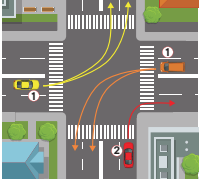
38
New cards
Right Turn (2)
Begin and end the turn in the lane closest to the right edge of the road. Do not swing wide into another lane of traffic.
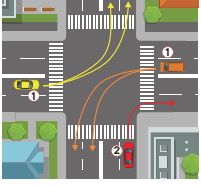
39
New cards
Left Turn from a 2-way Street onto a 1-way Street
Start the turn from the lane closest to the middle of the street (far-left lane). If there are three or more lanes in your direction of travel, you may end your turn in any lane that is open.
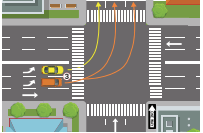
40
New cards
Left Turn from a 1-way street onto a 2-way street
Start the turn from the far-left lane. To reduce the risk of collision, end the turn in the left lane closest to the middle of the street going in your vehicle’s direction.
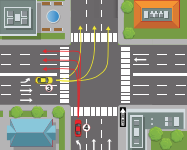
41
New cards
Left Turn from a 1-way St onto a 1-way St
. Start the turn from the far-left lane. Bicyclists can legally use the left turn lane for their left turns. If there are three or more lanes in your direction of travel, you may end your turn in any lane that is open.
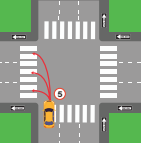
42
New cards
Right Turn from a 1-way onto A 1-way
Start the turn in the far-right lane. If safe, you may end the turn in any lane.
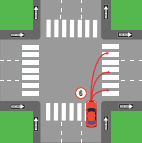
43
New cards
Turn at a “T” Intersection from a 1-way onto a 2-way
Traffic going straight through the intersection has the right-of-way. You may turn either right or left from the center lane.
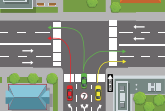
44
New cards
Braking
* Remove your foot from the gas pedal (accelerator) and allow the vehicle to slow down. Lightly press the brake until you come to a full stop. Give yourself enough space and time to perform this maneuver.
* When stopping at a limit line, __do not cross over the line__. If stopping behind a vehicle, leave enough space to __see their rear wheels__.
* When stopping at a limit line, __do not cross over the line__. If stopping behind a vehicle, leave enough space to __see their rear wheels__.
45
New cards
When Entering a Highway, you will need to (Merging)
* Be in the proper lane on the on-ramp.
* Be at or near the speed of traffic.
* Merge into highway traffic when safe to do so. Do not stop unless absolutely necessary.
* Merge into a space large enough for your vehicle to safely join the lane.
* Use your mirrors and turn signals.
* Turn your head quickly to look over your shoulder before changing lanes or merging into traffic.
* Make sure you can stop safely by leaving **three seconds of space** between you and the vehicle in front of you.
* Do not cross over any solid lines when merging. If you need to cross several lanes, signal and cross them **one at a time**. Check your blind spots for vehicles, motorcyclists, bicyclists, and pedestrians each time.
* Be at or near the speed of traffic.
* Merge into highway traffic when safe to do so. Do not stop unless absolutely necessary.
* Merge into a space large enough for your vehicle to safely join the lane.
* Use your mirrors and turn signals.
* Turn your head quickly to look over your shoulder before changing lanes or merging into traffic.
* Make sure you can stop safely by leaving **three seconds of space** between you and the vehicle in front of you.
* Do not cross over any solid lines when merging. If you need to cross several lanes, signal and cross them **one at a time**. Check your blind spots for vehicles, motorcyclists, bicyclists, and pedestrians each time.
46
New cards
To Exit a Highway Safely (Exiting)
* Know your exit and be aware of when it is approaching.
* If you plan to change lanes, do so one at a time. Signal and look over your shoulder to check your blind spots.
* When in the proper lane, **signal five seconds** (approximately 400 feet) before you exit.
* Make sure you are at a safe speed to exit.
* Do not cross over any solid lines when exiting.
* If you plan to change lanes, do so one at a time. Signal and look over your shoulder to check your blind spots.
* When in the proper lane, **signal five seconds** (approximately 400 feet) before you exit.
* Make sure you are at a safe speed to exit.
* Do not cross over any solid lines when exiting.
47
New cards
Crossing or Entering Traffic
You need a space that’s:
* Half a block on city streets, which is about 150 feet.
* A full block on the highway, which is about 300 feet.
* Even if you have a green light, do not start across the intersection if there are pedestrians or vehicles blocking your pathway.
* Half a block on city streets, which is about 150 feet.
* A full block on the highway, which is about 300 feet.
* Even if you have a green light, do not start across the intersection if there are pedestrians or vehicles blocking your pathway.
48
New cards
Passing
You must judge whether you have enough space to pass whenever you approach:
* An oncoming vehicle or bicyclist.
* A hill, curve, intersection, or road obstruction. To safely pass, the hill or curve should be at least **one-third of a mile ahead**.
* Before you pass, look ahead for road conditions that may cause other vehicles to move into your lane.
* An oncoming vehicle or bicyclist.
* A hill, curve, intersection, or road obstruction. To safely pass, the hill or curve should be at least **one-third of a mile ahead**.
* Before you pass, look ahead for road conditions that may cause other vehicles to move into your lane.
49
New cards
Do **NOT** Pass
* If you are approaching a hill or curve and cannot see if other traffic is approaching. This is very dangerous on one and two lane roads.
* Within 100 feet of an intersection, bridge, tunnel, railroad crossing, or other hazardous area.
* At crossroads and driveways.
* Unless you have enough space to return to your lane.
* Within 100 feet of an intersection, bridge, tunnel, railroad crossing, or other hazardous area.
* At crossroads and driveways.
* Unless you have enough space to return to your lane.
50
New cards
How to Pass
When you are going to pass on an open highway:
* Signal that you plan on passing.
* Look over your shoulder to check your blind spots.
* Drive into the passing lane.
* Speed up to pass the vehicle.
* Signal and return to your original lane.
You may pass on the __right__ only when:
* An open highway has two or more lanes going in your direction.
* The driver ahead of you is turning left and you can safely pass on the right. Never pass on the left if the driver is signaling a left turn.
* You are on a one-way street. Never drive off the paved or main-traveled part of the road to pass
* Signal that you plan on passing.
* Look over your shoulder to check your blind spots.
* Drive into the passing lane.
* Speed up to pass the vehicle.
* Signal and return to your original lane.
You may pass on the __right__ only when:
* An open highway has two or more lanes going in your direction.
* The driver ahead of you is turning left and you can safely pass on the right. Never pass on the left if the driver is signaling a left turn.
* You are on a one-way street. Never drive off the paved or main-traveled part of the road to pass
51
New cards
Parallel Parking
Parallel parking is when you park in line with the road and other parked vehicles. To parallel park:
1. Find a Space at least 3 ft longer than your vehicle, turn on your signal
2. Pull up alongside the vehicle in front of the space, leave about 2 ft between your vehicle and the vehicle next to you, stop once your rear bumper is aligned with the front of your parking space. Keep the signal on
3. Check your blind spots
4. Begin backing up, turn your steering wheel to back into the space at about a 45 degree angle
5. Straighten out, begin turning the steering wheel away from the curb when your rear wheel is within 18 inches of the curb, your vehicle should now be parallel and within 18 inches of the curb
6. Park
1. Find a Space at least 3 ft longer than your vehicle, turn on your signal
2. Pull up alongside the vehicle in front of the space, leave about 2 ft between your vehicle and the vehicle next to you, stop once your rear bumper is aligned with the front of your parking space. Keep the signal on
3. Check your blind spots
4. Begin backing up, turn your steering wheel to back into the space at about a 45 degree angle
5. Straighten out, begin turning the steering wheel away from the curb when your rear wheel is within 18 inches of the curb, your vehicle should now be parallel and within 18 inches of the curb
6. Park
52
New cards
Straight Line Backing
1. Traffic Check
2. Signal
3. Check your Blind Spots
4. Begin Backing Up -Back in a straight line __for__ __**three**__ __vehicle lengths__ while remaining __within__ __**three**__ __feet of the curb__. Stay aware of what is behind you when backing up.
5. Control - To maintain control of the vehicle, back at a __smooth__, __safe speed__ and __adjust__ the steering wheel when needed.
53
New cards
Parking on a Sloping Driveway
Turn the wheels so the vehicle will not roll into the street, leave the __vehicle in gear__ and set the __parking__ __brake__.
54
New cards
Parking when Headed Downhill
Turn your front wheels __into the curb__ or __right toward the side of the road.__

55
New cards
Parking when Headed Uphill
Turn your front wheels __away from the curb (left)__ and l__et your vehicle roll back a few inches__. The wheel should __gently touch the curb__.

56
New cards
Parking when Headed either Uphill or Downhill when there’s no curb
Turn the wheels so the __vehicle will roll away from the center of the road__ if the brakes fail.

57
New cards
Parking at Colored Curbs: White
Stop only long enough to pick up or drop off passengers
58
New cards
Parking at Colored Curbs: Green
Park for a limited time. The time limit may be posted on signs or painted on the curb.
59
New cards
Parking at Colored Curbs: Yellow
Load and unload passengers and freight. Do not stop longer than the time posted. If you drive a noncommercial vehicle, you are usually required to stay with your vehicle.
60
New cards
Parking at Colored Curbs: Red
No stopping, standing, or parking.
61
New cards
Parking at Colored Curbs: Blue
Parking for a disabled person or someone driving a disabled person with a special placard or special license plate.
62
New cards
Illegal Parking
* Where a No Parking sign is posted.
* On a marked or unmarked crosswalk.
* On a sidewalk, partially blocking a sidewalk, or in front of a driveway.
* Within three feet of a sidewalk ramp for disabled persons.
* In front of or on a curb that provides wheelchair access to a sidewalk.
* In the crosshatched (diagonal lines) area next to a designated disabled parking space.
* In a space designated for parking or fueling zero-emission vehicles, unless you are driving a zero-emission vehicle.
* In a tunnel or on a bridge, unless permitted by signs.
* Within 15 feet of a fire hydrant or fire station driveway.
* Between a safety zone and curb. Example of crosshatched (diagonal lines) area. 31
* Double parked.
* On the wrong side of the street or on a freeway, except:
* — In an emergency.
* — When a law enforcement officer requires a stop.
* — Where a stop is specifically permitted.
* On a marked or unmarked crosswalk.
* On a sidewalk, partially blocking a sidewalk, or in front of a driveway.
* Within three feet of a sidewalk ramp for disabled persons.
* In front of or on a curb that provides wheelchair access to a sidewalk.
* In the crosshatched (diagonal lines) area next to a designated disabled parking space.
* In a space designated for parking or fueling zero-emission vehicles, unless you are driving a zero-emission vehicle.
* In a tunnel or on a bridge, unless permitted by signs.
* Within 15 feet of a fire hydrant or fire station driveway.
* Between a safety zone and curb. Example of crosshatched (diagonal lines) area. 31
* Double parked.
* On the wrong side of the street or on a freeway, except:
* — In an emergency.
* — When a law enforcement officer requires a stop.
* — Where a stop is specifically permitted.
63
New cards
Driving Green
* Speed up and slow down smoothly. Drive at a steady speed.
* Regularly inflate your tires, get oil changes, and check filters.
* Get rid of extra weight in your vehicle.
* Regularly inflate your tires, get oil changes, and check filters.
* Get rid of extra weight in your vehicle.
64
New cards
During a Law Enforcement Stop
* Turn on your right turn signal to acknowledge that you see the officer.
* Move completely onto the right shoulder, even if in the carpool/HOV lane. Stop in a well-lit area when possible.
* Turn off your radio.
* Remain inside your vehicle unless directed to get out by the officer.
* Roll down your window after stopping your vehicle and before the officer makes contact with you.
* The driver and all passengers should place their hands in clear view before the officer makes contact with them.
* Move completely onto the right shoulder, even if in the carpool/HOV lane. Stop in a well-lit area when possible.
* Turn off your radio.
* Remain inside your vehicle unless directed to get out by the officer.
* Roll down your window after stopping your vehicle and before the officer makes contact with you.
* The driver and all passengers should place their hands in clear view before the officer makes contact with them.
65
New cards
Your Rights During the Enforcement Stop
* If an officer asks your permission to do something, you have a right to say no.
* The driver of a stopped vehicle must produce a driver’s license, proof of insurance, and vehicle registration when stopped by law enforcement.
* Only federal law enforcement officers can ask you about your immigration status.
* In general, the First Amendment protects the right of drivers and passengers to record interactions with law enforcement in public spaces.
* Even if you believe your rights were violated, you should not engage in physical resistance or violence against the officer.
* The driver of a stopped vehicle must produce a driver’s license, proof of insurance, and vehicle registration when stopped by law enforcement.
* Only federal law enforcement officers can ask you about your immigration status.
* In general, the First Amendment protects the right of drivers and passengers to record interactions with law enforcement in public spaces.
* Even if you believe your rights were violated, you should not engage in physical resistance or violence against the officer.
66
New cards
Solid Red Light
A red traffic signal light means STOP. You can turn right at a red light, if:
• There is not a NO TURN ON RED sign posted.
• You stop at the stop or limit line, yield for pedestrians, and turn when it is safe.
• There is not a NO TURN ON RED sign posted.
• You stop at the stop or limit line, yield for pedestrians, and turn when it is safe.
67
New cards
Red Arrow
A red arrow means STOP. Do not turn at a red arrow. Remain stopped until a green traffic signal light or green arrow appears.
68
New cards
Flashing Red Light
A flashing red signal light means STOP. After stopping, you may go when it is safe.
69
New cards
Solid Yellow Light
A yellow traffic signal light means CAUTION. The light is about to turn red. When you see a yellow traffic signal light, stop, if you can do so safely. If you cannot stop safely, cautiously cross the intersection.
70
New cards
Yellow Arrow
A yellow arrow means the protected turning time is ending. The signal will change soon. If you cannot stop safely or you are already in the intersection, cautiously complete your turn. Pay attention to the next signal. It could be a:
• Green or red traffic signal light.
• Red arrow.
• Green or red traffic signal light.
• Red arrow.
71
New cards
Flashing Yellow Light
A flashing yellow traffic signal light is a warning to PROCEED WITH CAUTION. Slow down and be alert. You do not need to stop
72
New cards
Flashing Yellow Arrow
You can turn, but your turn is not protected from other traffic. Proceed to turn left after yielding to oncoming traffic and proceed with caution.
73
New cards
Solid Green Light
A green traffic signal light means GO. You should still stop for any vehicle, bicyclist, or pedestrian in the intersection. Only proceed if you have enough space without creating a danger to any oncoming vehicle, bicyclist, or pedestrian. Do not enter the intersection if you cannot get completely across before the traffic signal light turns red.
74
New cards
Green Arrow
A green arrow means GO in the direction the arrow is pointing. The green arrow allows you to make a protected turn. Oncoming vehicles are stopped by a red traffic signal light.
75
New cards
Traffic Light Working
Treat it as a stop sign.
76
New cards
Diagonal Crossing
These are crisscross and diagonal crosswalks that allow pedestrians to cross the intersection in any direction at the same time. Cross only when the WALK signal allows it.

77
New cards
Red YIELD Sign
Slow down and be ready to stop to let any vehicle, bicyclist, or pedestrian pass before you proceed.
78
New cards
5-Sided Sign
You are near a school. Drive slowly and stop for children in the crosswalk.
79
New cards
Right-of-Way Rules
* The vehicle that arrives to the intersection first has the right-of-way
\
\
80
New cards
ROW: Without STOP or YIELD signs
* The vehicle that arrives to the intersection first has the ROW
* If a vehicle, pedestrian, or bicyclist gets to the intersection at the same time as you, give the ROW to the vehicle, pedestrian, or bicyclist on your right
* If a vehicle, pedestrian, or bicyclist gets to the intersection at the same time as you, give the ROW to the vehicle, pedestrian, or bicyclist on your right
81
New cards
ROW: T Intersections without STOP or YIELD signs
Vehicles, bicyclists, and pedestrians on the through road (continuing to go straight) have the right-of-way
82
New cards
ROW: Turning Left
Check for pedestrians. Give the right-of-way to any pedestrian or approaching vehicle that is close enough to be dangerous.
83
New cards
ROW: Turning Right
Always check for pedestrians crossing the street, and motorcycles and bicycles riding next to you
84
New cards
ROW: Green Traffic Signal Light
Proceed with caution. Pedestrians have the right-of-way
85
New cards
ROW: Entering Traffic
When entering traffic, you must proceed with caution and __yield to the traffic already occupying the lanes__. It is __against the law to stop or block an intersection__ where there is not enough space to completely cross before the traffic signal light turns red.
86
New cards
How to use a Roundabout
1. Slow down as you approach.
2. Yield to all traffic already in the roundabout.
3. Enter heading to the right when there is a big enough gap in traffic to merge safely.
4. Watch for signs and lane markings that guide you.
5. Travel in a counter-clockwise direction. Do not stop or pass.
6. Signal when you change lanes or exit.
7. If you miss your exit, continue around until you return to your exit.
\
87
New cards
How to use a Roundabout with Multiple Lanes (Right Turn)
Turn right (yellow car): Choose the right lane and exit in the right lane
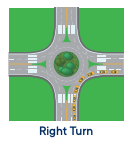
88
New cards
How to use a Roundabout with Multiple Lanes (Left Turn)
Turn left: Enter and continue driving until you reach the exit in the direction you choose (blue car).
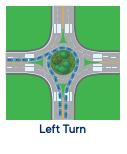
89
New cards
How to use a Roundabout with Multiple Lanes (Straight)
Go straight (red car): Choose either lane. Exit in the lane you entered.
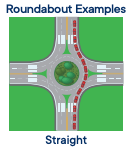
90
New cards
ROW: Mountain Roads
* The vehicle facing uphill has the ROW
* The downhill vehicle should back up until the vehicle going uphill can pass
* The downhill vehicle should back up until the vehicle going uphill can pass
91
New cards
Blind Spots (the No Zone)
Large vehicles and truck drivers have large blind spots; __no zones__
**If you can’t see the truck’s side mirrors, the truck driver cannot see you**.
**If you can’t see the truck’s side mirrors, the truck driver cannot see you**.
92
New cards
Braking (Sharing the Road)
* The average passenger vehicle traveling at 55 mph can stop within 300 feet.
* A large vehicle traveling at the same speed can take up to 400 feet to stop
* Do not move in front of a large vehicle and suddenly slow down or stop.
* A large vehicle traveling at the same speed can take up to 400 feet to stop
* Do not move in front of a large vehicle and suddenly slow down or stop.
93
New cards
Maneuvering (Sharing the Road)
* Change lanes directly in front of them to reach an exit or turn.
* Drive next to them longer than you need to. Always pass a large vehicle on the left side. After you pass the large vehicle or truck, move ahead of it. Driving alongside a large vehicle makes it hard for the driver to avoid dangers in the road.
* Underestimate their size and speed.
* Drive next to them longer than you need to. Always pass a large vehicle on the left side. After you pass the large vehicle or truck, move ahead of it. Driving alongside a large vehicle makes it hard for the driver to avoid dangers in the road.
* Underestimate their size and speed.
94
New cards
Buses, Streetcars, Trollers (Sharing the Road)
* When a bus, streetcar, or trolley is stopped at a safety zone or traffic light, you may pass at no more than 10 mph
* Do not overtake and pass a light rail vehicle or streetcar on the left side, whether it is moving or standing, unless:
* You are on a one-way street
* A traffic officer directs you to pass on the left
* Do not overtake and pass a light rail vehicle or streetcar on the left side, whether it is moving or standing, unless:
* You are on a one-way street
* A traffic officer directs you to pass on the left
95
New cards
Bicyclist Responsibilities
* Obey all traffic signs, signal lights, and basic right-of-way rules.
* Ride in the same direction as traffic.
* Always look over your shoulder to make sure the lane is clear before turning or changing lanes.
* Yield to pedestrians.
* Wear a helmet (if under 18 years old).
* Stay visible (for example, never weave between parked vehicles).
* Ride as near to the right curb or edge of the roadway as possible.
* Not ride on the sidewalk (unless allowed by the city).
* Make left and right turns in the same way drivers do, using hand signals and turn lanes.
* Use a bike lane, whenever possible, or use a through traffic lane.
* Have fully functional brakes
* Ride in the same direction as traffic.
* Always look over your shoulder to make sure the lane is clear before turning or changing lanes.
* Yield to pedestrians.
* Wear a helmet (if under 18 years old).
* Stay visible (for example, never weave between parked vehicles).
* Ride as near to the right curb or edge of the roadway as possible.
* Not ride on the sidewalk (unless allowed by the city).
* Make left and right turns in the same way drivers do, using hand signals and turn lanes.
* Use a bike lane, whenever possible, or use a through traffic lane.
* Have fully functional brakes
96
New cards
Bicycling at Night
* A front lamp with a white light visible from 300 feet.
* A built-in rear red reflector, solid red light, or flashing red light. This must be visible from 500 feet.
* A white or yellow reflector on each pedal, the bicyclist’s shoes, or their ankles. These must be visible from 200 feet.
* A white or yellow reflector on the front wheel, a white or red reflector on the rear wheel, or reflectorized tires.
* A built-in rear red reflector, solid red light, or flashing red light. This must be visible from 500 feet.
* A white or yellow reflector on each pedal, the bicyclist’s shoes, or their ankles. These must be visible from 200 feet.
* A white or yellow reflector on the front wheel, a white or red reflector on the rear wheel, or reflectorized tires.
97
New cards
Bicycling in Travel Lanes
* Bicyclists traveling slower than the flow of traffic must ride as close as possible to the right curb or edge of the road, unless:
* Passing a vehicle or another bicycle in the same direction.
* Preparing to make a left turn.
* Avoiding a hazard or road condition. Examples of turns for bicyclists. Intersections with special lanes for bicyclists. 50
* A lane is too narrow for a bicycle and a vehicle to safely travel sideby-side in the lane.
* Approaching a right turn.
* On a one-way road with two or more lanes. In this case, a bicyclist may ride near the left curb or edge of the road
* Passing a vehicle or another bicycle in the same direction.
* Preparing to make a left turn.
* Avoiding a hazard or road condition. Examples of turns for bicyclists. Intersections with special lanes for bicyclists. 50
* A lane is too narrow for a bicycle and a vehicle to safely travel sideby-side in the lane.
* Approaching a right turn.
* On a one-way road with two or more lanes. In this case, a bicyclist may ride near the left curb or edge of the road
98
New cards
Passing a Bicyclist
* When you cannot change lanes to pass a bicyclist, allow at least three feet between your vehicle and the bicyclist. If you cannot give three feet of space, do not pass the cyclist until three feet of clearance can be given
* Give bicyclists enough space so they are not forced into parked vehicles or open vehicle doors.
* Only merge toward the curb or into the bike lane when it is safe.
* Merge safely behind a bicyclist when preparing to make a turn.
* Enter a bike lane no more than 200 feet before starting a turn.
* Check for bicyclists when changing lanes or entering traffic. They may be hidden in a vehicle’s blind spots.
* Be careful when approaching or passing a bicyclist on a two-lane road.
* Give bicyclists enough space so they are not forced into parked vehicles or open vehicle doors.
* Only merge toward the curb or into the bike lane when it is safe.
* Merge safely behind a bicyclist when preparing to make a turn.
* Enter a bike lane no more than 200 feet before starting a turn.
* Check for bicyclists when changing lanes or entering traffic. They may be hidden in a vehicle’s blind spots.
* Be careful when approaching or passing a bicyclist on a two-lane road.
99
New cards
When to Move Over and Slow Down
* Stationary emergency vehicles or tow trucks displaying flashing amber warning lights.
* Stopped road work vehicles displaying emergency flashing or amber warning lights.
* Stopped road work vehicles displaying emergency flashing or amber warning lights.
100
New cards
Around Children
The speed limit is 25 mph within 500 feet of a school while children are outside or crossing the street.